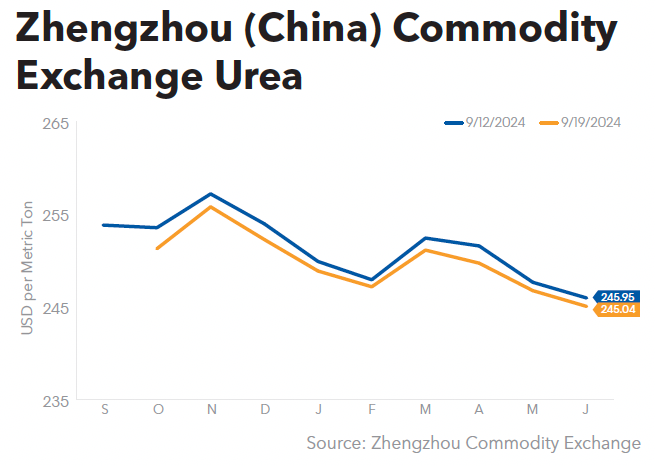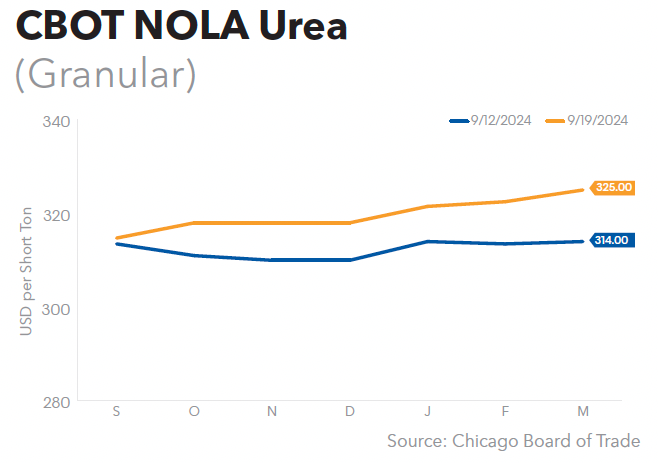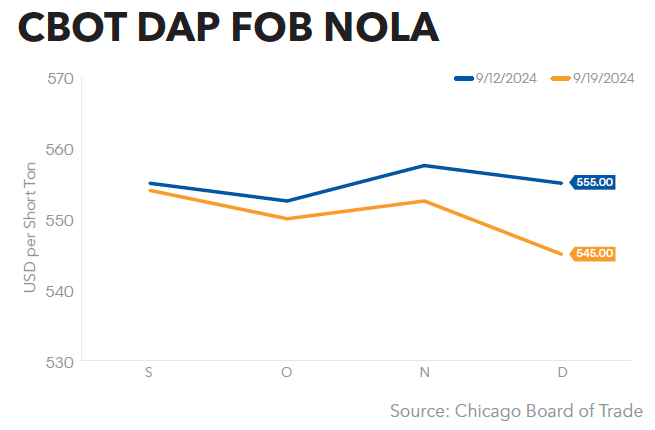


Hurricane Francine made landfall late Wednesday afternoon in southern Louisiana in the Parish of Terrebonne as a Category 2 hurricane, packing 100 mph winds and dumping up to nine inches of rain in some Louisiana locations. More than 390,000 Louisiana residents were without power on Sept. 12 as the storm churned inland as a tropical storm.
Francine is the third hurricane to strike the US mainland this year and the strongest to date, ahead of Hurricane Beryl in Texas and July and Hurricane Debby in Florida on Aug. 5, which both registered as Category 1 storms at landfall.
A hurricane warning was in effect across most of the Louisiana coastline at midweek, while a storm surge warning covered the area from the Vermilion and Cameron Parish line in Louisiana to the Mississippi and Alabama border. A state of emergency was declared by the governors of both Louisiana and Mississippi.
Truck loading operations were reportedly shut down at the CF Industries Donaldsonville, La., nitrogen complex and the Waggaman, La., nitrogen plant in advance of Francine’s landfall, industry sources reported. CF did not respond to requests for an operational status update at midweek.
The hurricane passed near six Gulf Coast refineries and 22 ports, according to Bloomberg, but did not make a direct hit on any of the region’s major natural gas export plants. Oil and gas companies such as Chevron Corp., ExxonMobil Corp., and Shell Plc shuttered and evacuated as many as 171 offshore platforms in the Gulf as a precaution, or roughly 46% of the 371 manned platforms in operation there.
The Bureau of Safety and Environmental Enforcement (BSEE) said people were evacuated from three non-dynamically positioned (DP) rigs while four DP rigs were moved out of the path of the storm, equating to 20% of the DP rigs operating in the Gulf. BSEE estimated that approximately 38.56% of the current oil production and 48.77% of the current natural gas production in the Gulf was shut-in in advance of the storm.
Louisiana’s Port Fourchon conducted emergency evacuations in preparation for the storm, while residents near ExxonMobil’s Beaumont, Texas, refinery were warned to shelter in place and seal doorways in case of a gas release from the plant.
BNSF Railway said it planned to stop interchanging traffic in the region in preparation for the storm, and the company issued a temporary permit embargo at midweek affecting all traffic originating or destined to move through the area.
Union Pacific reported on Sept. 10 that it was also taking precautions, including staging generators, water pumps, rail ballast and panels, additional diesel fuel, hotels, and supplemental transportation for crews.
Francine will likely cause $2-$3 billion in damages and losses, said Chuck Watson, a disaster modeler with Enki Research. The hurricane center is tracking three other disturbances in the central Atlantic Ocean that have potential to become tropical storms.
One upside to Francine as it moves inland is that it will bring much-needed water to the parched Mississippi River basin, where low water levels have threatened to roil shipments of fertilizer, corn, and fuel.
Fort Worth-based BNSF Railway has sharply increased the insurance coverage requirements for shippers of toxic inhalation hazard (TIH) chemicals, including anhydrous ammonia, prompting The Fertilizer Institute (TF) and other industry groups to draft a letter expressing “grave concerns” to CEO Katie Farmer.
As of Sept.1, BNSF is requiring shippers of TIH materials to have a minimum of $100 million in insurance coverage, up significantly from the prior $10 million minimum, Trains magazine reported. The move reportedly comes in the wake of the February 2023 hazardous materials derailment in East Palestine, Ohio, which has cost Norfolk Southern more than $1.7 billion to date, Trains reported.
BNSF is also requiring shippers to equally share liability for damages up to $1.8 billion where the cause of an accident is unclear or is caused by a third party. Additionally, the railway now requires shippers to accept full responsibility for and indemnify BNSF against liabilities over $1.8 billion.
“This 10-fold increase over BNSF’s current insurance requirement is excessive,” said TFI, the American Chemistry Council, Alliance for Chemical Distribution, The Chlorine Institute, and American Fuel & Petrochemical Manufacturers in an Aug. 28 letter to Farmer, which was also sent to members of the Surface Transportation Board (STB).
“With a limited number of insurance carriers in the market, your customers face significant challenges in obtaining coverage for their full range of products,” the letter states. “Moreover, the Sept. 1 deadline fails to provide customers with a reasonable amount of time to work through these challenges.”
BNSF Spokesman Zak Andersen said the higher insurance requirement is necessary and reasonable considering the risks involved with carrying TIH materials, and is “consistent with the levels of insurance these types of customers already carry in their business.”
“The changes we made to our insurance requirements in our TIH tariff terms were the first ones we have made in 20 years, and none of our revisions change the basic structure that our TIH customers have always shipped under,” he said. “We raised the insurance requirement to more closely reflect current realities, informed by recent events.”
TFI has sparred with the rail industry before over the common carrier obligation of Class 1 railroads to transport TIH commodities, including in 2007 when some railroads hiked freight rates for ammonia (GM Feb. 5; April 16, 2007) and in 2014 when certain railroads placed restrictions on the type of TIH tank cars they would accept (GM April 28, 2014).
Anderson warned that an incident involving a significant TIH release “could have financial impacts that jeopardize the ability of a railroad to continue operating.” One such accident occurred in January 2002 when a Canadian Pacific train derailment near Minot, N.D., caused an ammonia release that killed one local resident and sent dozens of others to the hospital (GM Jan. 21, 2002).
TFI and the other trade groups, however, argue in the letter that BNSF’s “unilateral rule changes impose unworkable insurance requirements and disproportionately shift greater liability to TIH customers.” They said liability should rest instead “on the party with operational control over safety,” noting that railroads “are the parties in the primary position to mitigate risks during transportation, including those associated with third-party actions and natural forces.”
OCI Global on Sept. 9 announced the sale of its methanol business to Canadian major Methanex for $2.05 billion. The purchase will be funded through a combination of approximately $1.15 billion in cash and the issuance of 9.9 million common shares, which will give OCI a 13% stake in Methanex. The transaction is expected to close in the first half of 2025.
Vancouver-based Methanex, one of the world’s largest methanol suppliers, will acquire OCI’s methanol assets in both the US and Europe, including OCI’s Beaumont, Texas, facility, which has methanol capacity of 910,000 mt/y methanol and ammonia capacity of 340,000 mt/y.
The deal also involves a 50% stake in a second Texas facility, operated by Natgasoline, with an annual capacity of 1.7 million mt of methanol, half of which will be acquired by Methanex and a facility in the Netherlands with a production capacity of 1 million mt/y.
“This transaction is testament to the efforts of an exceptionally talented group across OCI Methanol’s platform, who have prioritized value creation for the past 14 years,” said Bashir Lebada, CEO of OCI Methanol Group. “We are proud of OCI’s contributions to new applications, and in pioneering the use of methanol as a fuel globally, Methanex is well positioned to leverage OCI HyFuels to accelerate the transition to a low-carbon economy.”
“This is a unique opportunity to create value by acquiring two highly attractive North American methanol assets that will further strengthen our global production base and we expect it will be immediately accretive to free cash flow per share,” said Rich Sumner, Methanex President and CEO. “The Beaumont plants benefit from access to North America’s abundant and favorably priced supply of natural gas feedstock and are expected to increase our global methanol production by over 20%.”
The transaction marks OCI’s fourth divestment since December 2023, when the company announced the sale of its stake in Abu Dhabi-based Fertiglobe Plc to UAE state-owned oil giant ADNOC (GM Dec. 15, 2023).
In August OCI reported the sale of 100% of its stake in the low-carbon ammonia project under construction in Beaumont, Texas, to Australia’s Woodside Energy Group Ltd. for $2.35 billion (GM Aug. 9, p. 1). Just last week, OCI completed the sale of its Iowa Fertilizer Company LLC (IFCo) fertilizer plant in Wever, Iowa, to Koch Ag & Energy Solutions LLC for $3.6 billion (GM Sept. 6, p. 1).
Brazil’s state-controlled oil giant Petróleo Brasileiro SA (Petrobras) is accelerating a plan to re-enter the fertilizer industry as the country’s agricultural sector booms, Bloomberg reported on Sept. 6, citing people familiar with the matter.
Petrobras’s fertilizer initiatives include developing innovative technologies and assessing an estimated $800 million investment to complete works at a plant known as UFN-III, said the people, who asked not to be named since the discussions are private.
The company sees an opportunity within the sector as agricultural powerhouse Brazil heavily relies on fertilizers imports. Petrobras was a significant producer but decided to exit the business in 2018 under the previous government. The war in Ukraine disrupted fertilizer imports and sent prices to multi-year highs, prompting the administration of President Luiz Inácio Lula da Silva to rebuild the domestic industry.
Located in the country’s central west, work on UFN-III was halted in 2014 with around 80% of it completed. Petrobras managers are double-checking the $800 million investment forecast while also discussing potential partnerships, the people said.
Investment for the unit is expected to be detailed in Petrobras’s spending plan for 2025-2029 due in November, they added, without ruling out resuming works in December. Petrobras said in response to a request for comment that it is still evaluating the project and has no estimate of its value.
Resuming viable operations in assets that already belong to the company is the firm’s priority. Together, the four Petrobras fertilizer plants currently halted have capacity to supply 35% of Brazil’s demand for urea. Petrobras announced last month the resumption of its Araucaria fertilizer unit, which should happen by May 2025. It is also negotiating with fertilizer maker Unigel on a solution to restart two leased nitrogen units in Bahia and Sergipe.
Petrobras is also looking into innovation in the segment, such as ways of producing green ammonia. The oil giant on Sept. 6 announced a partnership with Brazilian agricultural research company Embrapa for research on renewable raw materials to obtain low-carbon products, including biofuels, green chemistry, and fertilizers.
Bunge Global SA has signaled that its $8.2 billion acquisition of Viterra Ltd. is inching closer, with the US agribusiness offering to replace debt previously issued by the Glencore Plc-backed firm, Bloomberg reported on Sept. 9.
The $1.95 billion debt-exchange offer comes after an initial delay to close the deal by August and is a sign the buyout is likely to be completed “over the coming months,” S&P Global Ratings said in a report. Regulatory approval is still pending in countries including Canada, where both companies have significant operations.
“We believe the announced transaction signals management’s increased confidence that the transaction will close sometime in the second half of 2024,” Chris Johnson, an analyst at S&P, said in the report.
Bunge, the ‘B’ in the storied ABCD quartet of agricultural commodity traders that have dominated crop markets for more than a century, agreed to acquire Viterra in June 2023 (GM June 16, 2023). The deal is expected to create a $25 billion behemoth capable of competing with the industry’s elite: Cargill Inc. and Archer-Daniels-Midland Co., the ‘A’ and the ‘C.’ Louis Dreyfus Co. represents the ‘D.’
Bunge has recently allayed competition concerns in Europe (GM Aug. 9, p. 28), agreeing to divest Viterra’s entire oilseeds business in Hungary and Poland. The transaction has also been approved by regulators in Brazil (GM May 17, p. 27) and Australia (GM Dec. 22, 2023).
Concerns remain in Canada, however, where the country’s Competition Bureau in April concluded that the deal is likely to result in “substantial anti-competitive effects” and a “significant loss of rivalry” between Viterra and Bunge in Canadian agricultural markets (GM April 26, p. 1).
“We continue to believe the combined operations in Canada do not have significant geographic overlap suggesting material conditional divestitures may not be required,” S&P said, adding it had raised Bunge’s outlook to positive, the first step toward lifting the company’s ratings.
The improved outlook comes even as Viterra has seen income halve this year, driven by a downturn in prices for everything from corn to soybeans. The company made a profit of $70 million in the first six months of 2024, Bunge said in a regulatory filing on Sept. 9, a drop from $141 million a year earlier.
Brazil’s Petrobras has signed a Cooperation Agreement with Embrapa, a Brazilian state-controlled agricultural research company, to develop technical studies on renewable raw materials to obtain low-carbon products, including fertilizers.
The partnership is expected to have Petrobras develop technical solutions and industrial units for the production of biofuels and bioproducts while Embrapa will develop a protocol for low-carbon agriculture crops, such as soybeans, including certification protocols. The agreement also includes the development of cultures off-season, such as second-crop corn and Ethiopian mustard, among other options.
“Diversity and sustainable access to raw materials, quality, and adequate costs are essential to the success of those initiatives, such as biofuels,” said Petrobras President Magda Chambriard. “Furthermore, the company is interested in offering fertilizing products to boost availability in the domestic market and meet the targets of the National Fertilizer Plan. Embrapa has the necessary expertise to contribute to such projects.”